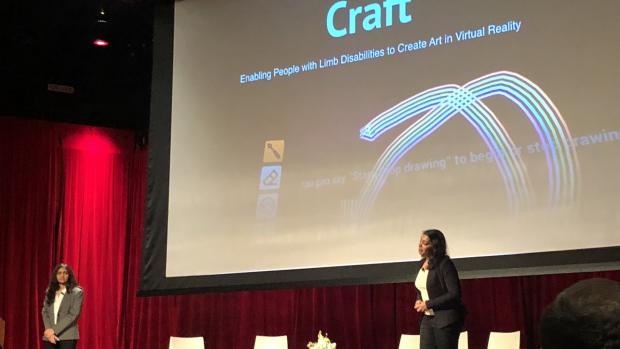Future Reality: Augmented, Virtual, Mixed, or Extended ... It’s Already Here
Tandon faculty and students pitch ideas at NYC Media Lab event

Tandon students at the Exploring Future Reality event present their platform that allows people with limb disabilities to create art in virtual reality
With more and more virtual-reality and augmented-reality tools and applications being built, the market for them is expected to reach $95 billion by 2025. It’s a staggering number — and the possibilities are equally staggering according to experts at an annual event dubbed Exploring Future Reality.
Each year, the NYC Media Lab — a wide-ranging public-private initiative that counts as members the city’s leading media, technology and telecom companies, as well as faculty and students from several universities, including NYU — hosts the event, jam-packing it with panel discussions, demos, hands-on workshops, and startup pitches.
This year’s installment took place on November 29 at the Kimmel Center, and opened with Media Lab Director Justin Hendrix, who treated the standing-room-only audience to a sneak peek at the new RLab. Led by NYU Tandon, the RLab is a city-funded center located at the Brooklyn Navy Yard, dedicated to research, entrepreneurship, and education in mixed reality and other evolving interactive technologies. “Over the last three decades our platforms have evolved, from PCs to Web, to mobile,” Hendrix explained. “This is the newest frontier.”
A subsequent discussion on AR, VR, and drones found Tandon represented by Giuseppe Loianno, who heads the school’s new Agile Robotics and Perception Lab. Loianno described his most recent research, the development of an easy-to-use, self-contained system that will allow pilots with even limited experience to safely and reliably control a drone with just a pair of gaze-tracking glasses and a small computing unit. (No motion-capture system or even GPS is needed, and because of that, the system as a whole is the first of its kind ever to be demonstrated.) “The drone industry is at a similar stage as the automotive industry back at the turn of the last century,” he said. “Cars had been invented, but drivers weren’t yet being regulated, and the technology was rapidly evolving. Soon drones will be used in almost any sector you can think of, from infrastructure and transportation to agriculture and manufacturing.” Questioned about the bad press drones sometimes get, he made another apt analogy, explaining that while knives, in the wrong hands, can be used for nefarious purposes, they are an indispensable tool when used properly. “It is the role of first, parents, and then educational institutions such as Tandon to ensure that future generations use technology wisely.”
Certainly, most of those in attendance were eager to learn more and to leverage the latest technology to improve the world. That ethic was very much in evidence among the youngest attendees — the student founders who had taken part in the RLab’s inaugural XR Startup Bootcamp and who were pitching their ideas at the event. Tandon teams included Unseen Media (Casey Judge, Alexandros Lotsos, Gabriella Cammarata, and Brian Hui), aimed at developing compelling, interactive, immersive games with a variety of themes; and Craft (Cherisha Agarwal, Raksha Ravimohan, Pratik Jain, Shimin Gu, and Srishti Kush), developers of a platform that allows people with limited limb mobility to create artworks using eye movements and voice commands.
With well-attended workshops on everything from building a cloud-connected AR app to using 360° VR video for immersive storytelling, next year’s Exploring Future Reality is bound to include even more enthusiastic participants and exciting projects.




